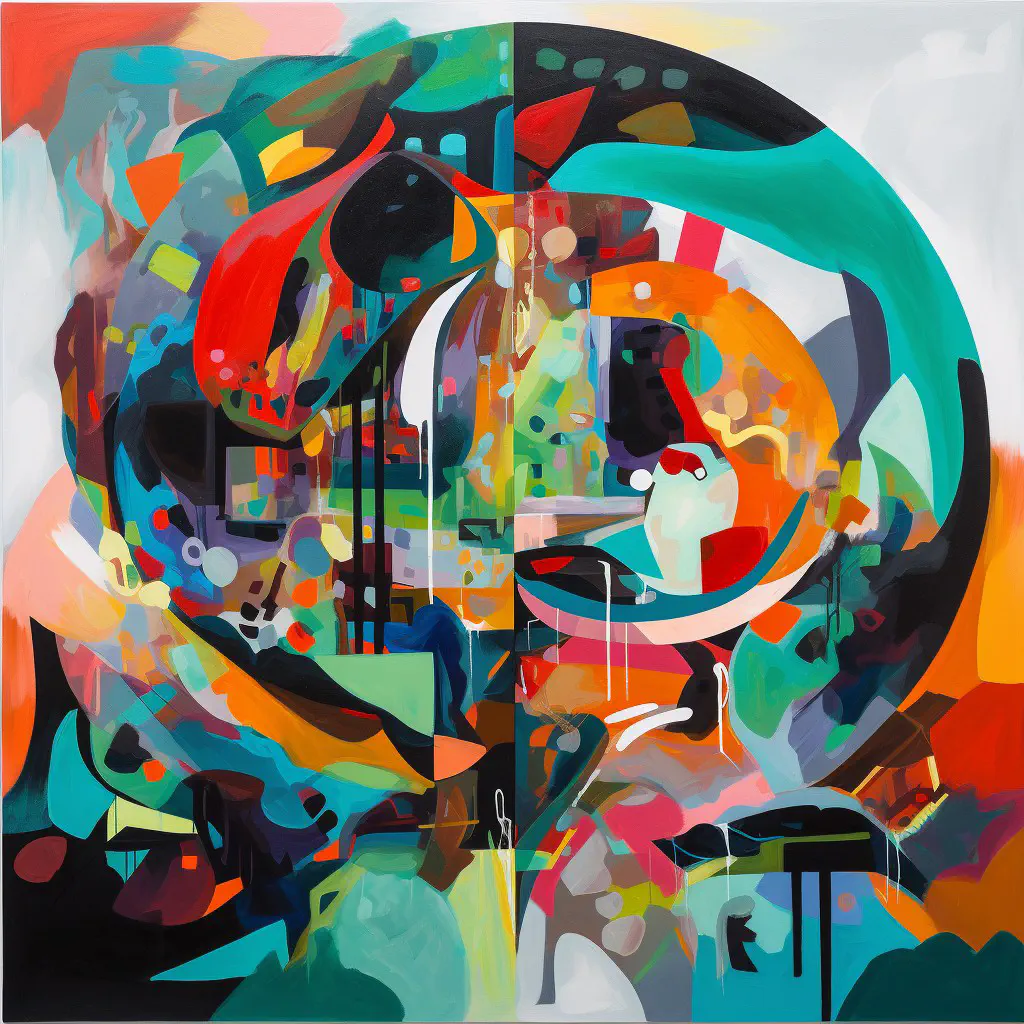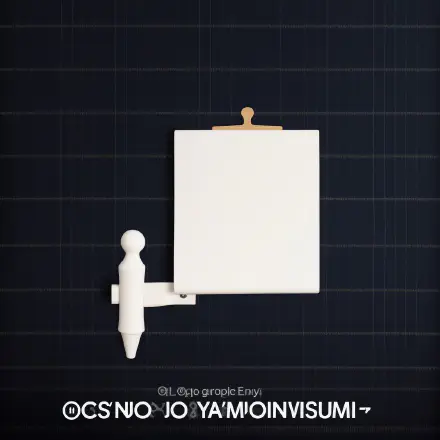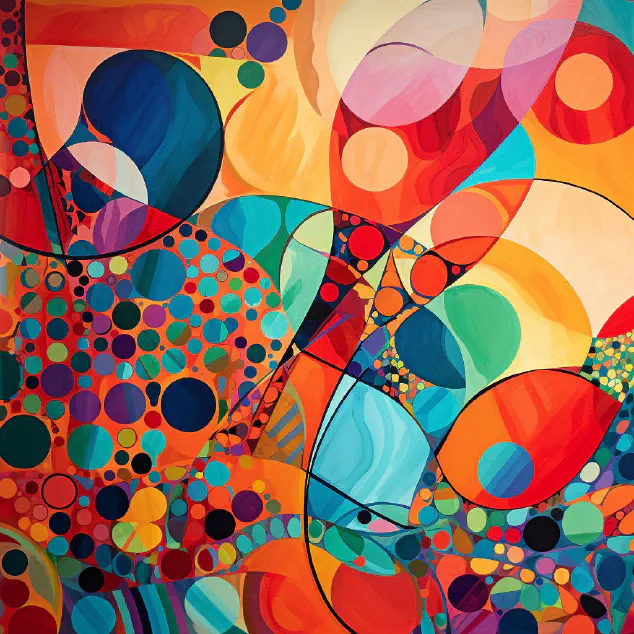
Introduction
Abstract art has been a prominent genre of art for almost a century and yet, it still sparks confusion and skepticism from many people. Most people tend to think of abstract art as random colors and shapes that artists throw onto a canvas randomly. However, this couldn’t be farther from the truth. Abstract art has the power to evoke unexpected emotions and perceptions in people.
As humans, we perceive and interpret things based on our unique life experiences, societal norms, and values. Abstract art is no different. People perceive abstract art differently based on their individual backgrounds, past experiences, and even mood at the time of viewing. Interestingly, our perception of abstract art is also influenced by what psychologists refer to as the Gestalt principles of perception. These principles govern how humans perceive and interpret information from the world around us.
In this article, we will examine the surprising psychology behind abstract art, exploring the role perception plays in how we interpret it, the emotions it can evoke, why it has universal appeal, the psychology of abstract art appreciation, and how we can better appreciate it.
The role of perception in abstract art
When it comes to abstract art, one of the most interesting things is how perception plays a crucial role in how people interpret and respond to the artwork. Unlike with representational art, where there is a clear subject matter and the aim is to create a faithful representation of it, abstract art is much more open to interpretation. This is because the artwork often lacks a clear subject matter, instead, it relies on color, form, line, and texture to create a visual experience.
Exploring the Gestalt principles of perception
To understand how perception works in abstract art, it is helpful to explore the Gestalt principles of perception. These are a set of principles that describe how people organize and interpret visual information. For example, the Gestalt principle of proximity describes how our brains group things together that are close to each other. The principle of similarity describes how we group things together that are similar in shape or color. The principle of continuity describes how we perceive things as having a continuous shape, even if they are interrupted.
Pointing how the principles apply to abstract art
These principles apply to abstract art in interesting ways. For example, an abstract artwork that features a series of lines of different colors close together can use the principle of proximity to create a sense of unity and wholeness. Similarly, an abstract artwork that features overlapping shapes with varying shades of the same color can use the principle of similarity to create a sense of depth and complexity.
Overall, our perception of abstract art is shaped by many factors, including our past experiences, our cultural background, and our personal preferences. As a result, different people may interpret the same artwork in very different ways. This is part of what makes abstract art so fascinating and engaging. It invites us to use our imagination and creativity to make sense of the visual world around us.
Emotions evoked by abstract art
Abstract art has the power to stir up emotions in people in ways they might not expect. It has the potential to evoke a range of emotions from the viewers like serenity, fear, joy, and sadness. Some people might come across abstract art that creates a calm and peaceful atmosphere, while others might experience fear or anxiety.
According to a study published in the journal of Frontiers in Human Neuroscience, viewers of abstract art often undergo profound emotional experiences. The study found that when people view abstract art, their brains interpret the images in a way that can evoke a wide range of emotions. This is because abstract art images can activate the viewer’s imagination, allowing them to interpret what they see in different ways.
One of the most startling experiences that abstract art can offer is its ability to be cathartic. Many people find that looking at abstract art can be a therapeutic way to process emotions and work through difficult experiences. For example, they might see their pent-up emotions symbolized in the colors or shapes presented in the art piece.
In addition to allowing viewers to process their emotions, abstract art can also inspire joy or wonder. An abstract art piece might feature vivid colors and dynamic shapes that are visually stimulating and pleasing to the eye. At the same time, abstract art can also be thought-provoking, challenging our perceptions and inviting us to see the world in new and unexpected ways.
In conclusion, abstract art is a powerful form of expression that can evoke strong emotions from its viewers. Whether it’s calming or cathartic, thought-provoking or inspiring, abstract art has something to offer everyone who takes the time to appreciate it.
The universal appeal of abstract art
Abstract art, unlike conventional art, has an extraordinary ability to transcend cultural, geographical, and language barriers. It is one of the defining features of the genre and speaks to a universal language of emotions, perception, and expression. Here are some reasons why abstract art has universal appeal:
Non-representational nature
One of the compelling things about abstract art is that it doesn’t aim to represent a specific object or scene. This non-representational approach opens up a wide range of interpretations that are not limited by cultural or geographical influences. Such art allows viewers to form their own opinions and feelings, uninhibited by any preconceived notions.
Emotional impact
Abstract art is often visually charged with colors, forms, and textures that evoke deep emotions and interpretations in the viewer. Because it doesn’t represent specific objects, abstract art relies on colors, lines, shapes, and textures to convey its message, leading to an exceptional emotional impact that is not limited by cultural or geographic influences.
Freedom of expression
Abstract art provides artists with complete creative freedom. This creative freedom enables artists to express their ideas, feelings, and emotions without the need to conform to traditional or cultural norms. This aspect makes abstract art relatable to anyone who has ever experimented with art.
Aesthetically pleasing
There is no denying that abstract art is visually stunning. It is filled with bright colors, bold lines, and irregular shapes that are pleasing to the eye. Abstract art has a certain depth and complexity that can pique anyone’s interest, regardless of their cultural background or language.
Renowned artists
Many abstract artists like Kandinsky, Pollock, and Rothko have achieved global recognition for their unparalleled abstract art. Their works can be found in galleries and museums worldwide, transcending cultural and linguistic barriers.
In summary, abstract art is truly a universal art form that has the potential to stir emotions, conversation, and cross-cultural understanding. It evokes deep feelings in people and speaks to a universal language of human emotions and perceptions. Abstract art has cemented its place in the art world and remains an essential part of our society.
The psychology of abstract art appreciation
Understanding the psychology behind abstract art can help one appreciate it more deeply. Appreciation of art depends on an individual’s past experiences, knowledge, and culture. People have differing interpretations of abstract art.
Personal experiences and background influencing abstract art appreciation
People interpret and understand art differently based on their experiences and personal background. Someone who has experienced trauma may interpret a piece of abstract art differently from someone who has not. For instance, a painting that appears chaotic to one person may evoke feelings of nostalgia or comfort for another.
Differing interpretations of abstract art
Abstract art is open to different interpretations and meanings. Some people may find it difficult to understand, but this is because it doesn’t necessarily have a pre-determined message. Everyone perceives abstract art differently, and their interpretations can change over time. Our views on abstract art can shift depending on our emotions, new experiences, or the context in which we view them.
Tips for appreciating abstract art
Aside from the emotional and psychological aspects of interpreting abstract art, there are technical aspects to consider.
When appreciating abstract art, focus on the colors, forms, and interpretation. Consider the painting’s structure, balance, and use of color. Instead of trying to uncover a meaning, try to appreciate the aesthetics and formal elements of the work. The interpretation of abstract art does not necessarily depend on understanding the artist’s intention but on the viewer’s experience.
In conclusion, abstract art can evoke deep emotions and perceptions in viewers. Understanding the psychology behind it can lead to a greater appreciation of its intricacies and beauty. The subjective interpretations open up different ways to look at an art piece. It’s vital to consider both the emotional and technical aspects of abstract art to perceive its true beauty.
Conclusion
In summary, the world of abstract art is much more complex and dynamic than the popular belief that it is just random colors and shapes. As we have explored, abstract art has the power to evoke unexpected emotions and perceptions from individuals, making it a potent vehicle to communicate different expressions, emotions, and ideas.
Furthermore, abstract art has shown to be universal in its appeal, transcending all cultural, language, and geographic boundaries. The fact that people from different backgrounds can appreciate and interpret abstract art differently is an unexpected yet powerful testament to its significance in the art world and the broader society.
To appreciate abstract art, it’s important to harness your perception and focus on the colors, forms, and interpretation of the art piece. Always remember that your past experiences and background can influence the way you feel about abstract art, and that differing interpretations of abstract art can coexist in one artwork.
In conclusion, it is essential to embrace and appreciate abstract art. By doing so, you become a part of a community that revels in the endless possibilities that art can offer in all its abstract glory. As the famous abstract artist Wassily Kandinsky once said, “Art is the mirror of the soul; and eyes can see into the soul of the abstract as well as the representational picture.”


